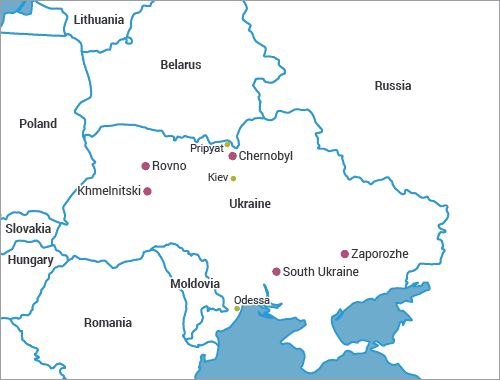 |
| The damaged Chernobyl unit 4 reactor building |
- The Chernobyl accident in 1986 was the result of a flawed reactor design that was operated with inadequately trained personnel.
- The resulting steam explosion and fires released at least 5% of the radioactive reactor core into the environment, with the deposition of radioactive materials in many parts of Europe.
- Two Chernobyl plant workers died due to the explosion on the night of the accident, and a further 28 people died within a few weeks as a result of acute radiation syndrome.
- The United Nations Scientific Committee on the Effects of Atomic Radiation has concluded that, apart from some 5000 thyroid cancers (resulting in 15 fatalities), "there is no evidence of a major public health impact attributable to radiation exposure 20 years after the accident."
- Some 350,000 people were evacuated as a result of the accident, but resettlement of areas from which people were relocated is ongoing.
- On 24 February Ukraine informed the International Atomic Energy Agency that Russian forces had taken control of all facilities at Chernobyl (see below).
- On 9 March the Chernobyl nuclear plant was disconnected from the electricity grid. The IAEA stated that it did not see a critical impact on safety as a result.
The April 1986 disaster at the Chernobyla nuclear power plant in Ukraine was the product of a flawed Soviet reactor design coupled with serious mistakes made by the plant operatorsb. It was a direct consequence of Cold War isolation and the resulting lack of any safety culture.

The accident destroyed the Chernobyl 4 reactor, killing 30 operators and firemen within three months and several further deaths later. One person was killed immediately and a second died in hospital soon after as a result of injuries received. Another person is reported to have died at the time from a coronary thrombosisc. Acute radiation syndrome (ARS) was originally diagnosed in 237 people onsite and involved with the clean-up and it was later confirmed in 134 cases. Of these, 28 people died as a result of ARS within a few weeks of the accident. Nineteen more workers subsequently died between 1987 and 2004, but their deaths cannot necessarily be attributed to radiation exposured. Nobody offsite suffered from acute radiation effects although a significant, but uncertain, fraction of the thyroid cancers diagnosed since the accident in patients who were children at the time are likely to be due to intake of radioactive iodine falloutm,9. Furthermore, large areas of Belarus, Ukraine, Russia, and beyond were contaminated in varying degrees. See also sections below and Chernobyl Accident Appendix 2: Health Impacts.
The Chernobyl disaster was a unique event and the only accident in the history of commercial nuclear power where radiation-related fatalities occurrede. The design of the reactor is unique and in that respect the accident is thus of little relevance to the rest of the nuclear industry outside the then Eastern Bloc. However, it led to major changes in safety culture and in industry cooperation, particularly between East and West before the end of the Soviet Union. Former President Gorbachev said that the Chernobyl accident was a more important factor in the fall of the Soviet Union than Perestroika – his program of liberal reform.
Read more:
https://world-nuclear.org/information-library/safety-and-security/safety-of-plants/chernobyl-accident.aspx










Δεν υπάρχουν σχόλια:
Δημοσίευση σχολίου